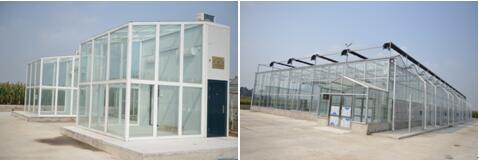Location:
The headquarter of Shenyang Experiment Station of Ecology is located at Shilihe town (N41°32′, E123°23′), Sujiatu district, Shenyang, Liaoning Province, China. It is 35 km from the center of Shenyang City.

Natural Conditions of the Area:
The station is located at the lower reaches of Liaohe River Plain. This area belongs to warm-temperature zone and the local weather is typical of a humid continental monsoon climate. There are four distinct seasons and it is hot in summer and cold in winter. The mean annual temperature is 7.0-8.0℃, with a maximum of 39.3℃ and a minimum -33.1℃. The total radiant energy is 1292.8-1350.2 kcal/cm2 and the mean annual active accumulated temperature of ≥10℃ is 3300-3400℃. The frost-free period is 147-164 days per year. The mean annual precipitation is 570-680 mm and the annual evaporation is 1408-1765 mm.
This area belongs to concentrated cities-towns and has a population of 16,500,000. It is a key base of industry and agriculture of China, as one of most flourishing economy area in Northeast. The type of soil is meadow burozem and the total cultivated area is about 1,500,000 ha. The main crops are rice, maize, soybean and sorghum with the annual grain production over 6,000 kg per ha.

History:
This ecological experiment station was proposed to be established in Shenyang in 1985, and the station was put into operation in the spring of 1990. It was selected as one of the key stations of Chinese Ecosystem Research Network in May, 1992, and became one of the field open stations of Chinese Academy of Sciences in November, 1997. In 2005, the station was approved as National Field Observation and Research Station.
Objectives:
For industrial and agricultural development and local ecological construction, the station specializes in the studies on the structure and function of main agroecosystems based on the biogeographical characteristics of the Song-Liao Plain. In accordance with the frontier in applied ecology, we focus on the key ecological processes and mechanisms as well as regulation functions. We explore the ecological effects of pollutants and try to find efficient way to reduce their environmental risk. All of the researches aim to favor the sustainable development of agriculture by rational use of resources, and promote the development of agro-ecology and pollution ecology.
Research Environment:
The station covers an area of 14.4 ha. The total building area is more than 1700 m2 including a comprehensive building, storerooms, sample storehouses, laboratories and a dining hall. There are offices, academic report hall, computer room, archives and exhibition rooms in the comprehensive building. There are also guest rooms for the researchers working at the station.
The experiment field in the station is about 12 ha including both arable and paddy field. The long term treated experiments mainly include nutrient cycling and regulation experiment, pollution ecological and safe use of polluted land experiment and global change simulation experiment, etc.
Research Facilities:
There are many types of research facilities for all-weather experiments, mainly including open top chambers (11), sunlight greenhouse (600m2), glass greenhouse (960m2), and artificial climate chamber(2).

Monitoring Work:
There are nine observation sites of water, soil, gas and growth period of crop in the station, including an automatic meteorological observation field (energy balance observation field), two comprehensive observation fields of farmland ecosystem (including water and fertilizer coupling balance field), five long-term auxiliary observation sites (different tillage and fertilizer manegements) and a surface water quality observation field. A total of sixteen automatic observation acquisition systems are set up in the observation site: water surface evaporation observation system, groundwater level observation system, atmospheric background data acquisition system, eddy observation systems (carbon dioxide and water flux observation), soil moisture observation system and observation system of plant growth rhythm. The monitoring data set was formed through long-term measurement of meteorology, water, biology and soil samples. The data set contains solar radiation, air temperature, ground temperature, precipitation, soil water and other meteorological environmental factors real-time observation, dynamic observation data of crop phenological period, biomass, leaf area and the content of soil nutrient and heavy metal, accumulated a large number of basic data for ecology, environmental science and related disciplines resources.
Station head:
Dr. Chen Xin
Station address:
No.20 Caiji St., Sujiatun District, Shenyang, Liaoning Province, China
Mailing address:
Institute of Applied Ecology, Chinese Academy of Sciences
P.O. Box 32
72 Wenhua Rd.
Shenyang, 110016, China
Tel : 86-024-83970208
E-mail: chenxin@iae.ac.cn



